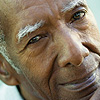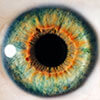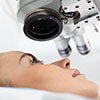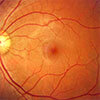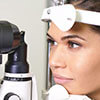In-N-Out Burger is a fast-food restaurant chain that was founded in Southern California in 1948–seven years before McDonald’s was founded in the same region. In-N-Out is unique among large American fare fast-food chains, not necessarily because of its quality (though I am definitely a fan), but because of the simplicity of its menu. The menu consists of only 5 bold-lettered food items, along with a short list of smaller-font drinks. In-N-Out has capitalized on the idea that, in general, people like to choose from a short list of tried-and-true options, rather than being presented with a seemingly infinite list of choices.

Figure 1. In-N-Out Burger Menu
Not many years ago, choosing an intraocular lens (IOL) for a patient’s cataract surgery was much like ordering from In-N-Out—the choice was more simple because there were a limited number of IOL types to choose from. Now, the world of IOL technology is evolving so rapidly that new types of lenses are being “added to the menu” every year. With so many different IOL’s now FDA-approved (and many more in the pipeline), the wide variety of options can seem overwhelming for both providers and patients.
For example, current IOL options available in the US include monofocal, slightly extended depth of focus monofocal, toric, multifocal (bifocal and trifocal), extended depth of focus (EDOF), multifocal/EDOF toric, accommodating, and light-adjustable. Many of these IOL categories have offerings from multiple manufacturers that are slightly different from one another. Keeping up-to-date with the latest IOL technology can seem like a daunting task, but doing so is important for all providers who care for cataract patients. Knowing how different IOL’s function, as well as the advantages and drawbacks of each, can allow us to better determine which IOL is most likely to meet our patients’ visual goals.
Just like choosing from a restaurant menu with dozens of entrées can seem overwhelming, mentioning a laundry list of IOL options to our patients can leave them confused and frustrated. “Simplifying the menu” and offering targeted options to our patients can help them feel more satisfied with their choice, and can make our chair-time with patients more efficient.
Many of our patients are aware that newer technology allows us to more precisely correct refractive error at the time of cataract surgery. Some of these patients want to limit their need for glasses or contacts as much as possible after surgery. The segment of IOL technology that allows us to come closest to that ideal is presbyopia-correcting technology.
Since there are several different types of presbyopia-correcting IOL’s now available on the market, having a basic understanding of what each can offer to our patients is very helpful. Please see the table below for a comparison between some of the newer options available, as well as one that recently got pre-market FDA approval in May 2021.
Table 1. Presbyopia-correcting Intraocular Lens Comparison
| IOL | PanOptix | Vivity | SymFony | Synergy (pre-market FDA approval) |
| IOL Manufacturer | Alcon | Alcon | Johnson & Johnson | Johnson & Johnson |
| IOL Class | Multifocal (Trifocal) | EDOF | EDOF | EDOF/Multifocal |
| Distance acuity | Good | Excellent | Good | Excellent |
| Intermediate | Good | Good | Good | Good |
| Near | Good | Often usable | Often usable | Excellent |
| Glare and haloes | Mild-Moderate | Minimal | Mild-Moderate | Mild |
| Contrast Sensitivity | Moderate decrease | Slight decrease | Moderate decrease | Slight Decrease |
| Can use with other ocular pathology |
No | YES | No | Possibly |
| Unique Qualities | Glasses independence at all distances |
Minimal glare or contrast reduction, can implant with other ocular pathology | First EDOF IOL | “Continuous” depth of focus from near to far. “Violet blocking” to decrease glare |
| Ideal Patient | Desires glasses independence at all distances, OK with slight limitation in quality of vision and risk of glare/haloes | Wants good intermediate VA in addition to distance w/ minimal risk of haloes +/- has other ocular pathology | Wants good intermediate to distance VA, OK with risk of haloes | Desires glasses independence at all distances |
Beyond those listed in the table, other presbyopia-correcting IOL technologies are currently in development. One that is particularly exciting is Juvene (see Figure 2): a truly accommodating IOL designed by LensGen that changes in curvature with contraction of the ciliary body, similar to the natural crystalline lens. The amplitude of accommodation was found to be about 3 diopters, which would provide an excellent range of vision without causing unwanted dysphotopsias or decreased contrast sensitivity.

Figure 2: Juvene multi-component IOL. When the ciliary body is relaxed, the anterior curvature of the IOL is flatter and focused for clear distance vision (upper frame). When the ciliary body contracts, the anterior curvature becomes steeper, allowing for better intermediate and near vision (lower frame).
The advancement of IOL technology will continue to amaze us in the coming years. As new IOL’s are released, we should study the properties of each so that we can provide informed counseling to our patients. “Simplifying the menu” of IOL’s for patients by providing personalized recommendations will help us maintain a high level of patient satisfaction. To our comanaging providers: thank you for giving us the opportunity to improve your patients’ quality of life through surgical eye care. We look forward to the progressively brighter future of cataract patient care as IOL technology continues to improve.
References:
- “History – In-N-Out Burger”. In-n-out.com/history.html, 2021.
- Sudhir, Rachapalle Reddi MD, MPH; et al. † AcrySof IQ PanOptix Intraocular Lens Versus Extended Depth of Focus Intraocular Lens and Trifocal Intraocular Lens: A Clinical Overview, Asia-Pacific Journal of Ophthalmology: July-August 2019 – Volume 8 – Issue 4 – p 335-349
- Tran DB, et al. Visual Acuity, Quality of Vision, and Patient-Reported Outcomes After Bilateral Implantation with a Trifocal or Extended Depth of Focus Intraocular Lens. Clin Ophthalmol. 2021 Feb 3;15:403-412. doi: 10.2147/OPTH.S295503. PMID: 33568894; PMCID: PMC7868299.
- Kanclerz, Piotr et al. “Extended Depth-of-Field Intraocular Lenses: An Update.” Asia-Pacific journal of ophthalmology (Philadelphia, Pa.) vol. 9,3 (2020): 194-202.
- Arrigo A, et al. Extended depth-of-focus (EDOF) AcrySof® IQ Vivity® intraocular lens implant: a real-life experience. Graefes Arch Clin Exp Ophthalmol. 2021 May 29. doi: 10.1007/s00417-021-05245-6. Epub ahead of print. PMID: 34050809.
- Bontu S, et al. Long-term uveal and capsular biocompatibility of a new fluid-filled, modular accommodating intraocular lens. J Cataract Refract Surg. 2021 Jan 1;47(1):111-117.

Author: Paul Israelsen, MD
Specialties: Cataract
I love working at Northwest Eye Surgeons because I get to work so closely with other eye care providers in delivering top-notch surgical and perioperative care to our patients. I chose to write this post to encourage us all to keep up to date with new intraocular lens technologies. Doing so will improve our patient counseling and, in turn, their satisfaction with their care.


